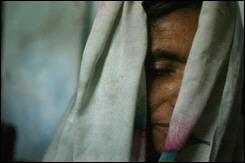Trafficked Indian
Susan notes: this AFP story was initially published in February 2008; but not much has changed for trafficked women in India since then...
 The wrinkles on Sumari's face betray her troubled past, making her look far older than the nearly 40 years she believes she is.
The wrinkles on Sumari's face betray her troubled past, making her look far older than the nearly 40 years she believes she is.
Widowed young, she was brought from her native village to northern India and sold to a man who abused her sexually and physically, and imprisoned her and her daughter in his house.
"It went on for three or four months, until he sold us off to another man," says Mumtaz, Sumari's daughter, who is now about 20.
Sumari is one of the luckier women, having eventually found a good husband after being sold repeatedly in a thriving human trade in northern India that is blamed on local customs and a shortage of women.
More than 10,000 women like her are believed to have been bought or lured with the promise of a job from poorer Indian states in recent years to be married to men who cannot find wives.
"There aren't enough girls here. Locals won't give their girls to widowers, ageing and handicapped men," said Fatima, Sumari's neighbour in Mewat, a district of Haryana state where there are 820 girls for every 1,000 boys under the age of six.
This compares to a national average of 927 to 1,000, and the worldwide average of 1,050 girls for every 1,000 boys.
Experts say abortion of female foetuses because of the traditional Hindu preference for sons in this male-dominated society has led to a severe shortage of women in Haryana, and upset the sex balance nationwide.
Mewat, just 50 kilometres (30 miles) from New Delhi, was carved out as a separate administrative zone from Gurgaon district -- which boasts high-rise offices and upmarket malls -- and stands in stark contrast to India's impressive growth story.
Bride trafficking has been well-documented here and while the impact on the region's sex ratio is a major concern, the problem is complicated by other factors such as acute poverty and early marriage.
"Many women die during childbirth here, leaving a large number of widowers who can't find local girls. They have to buy them," said Manmohan Sharma of the non-profit Voluntary Health Association of Punjab, which campaigns against female foeticide.
Trafficking in India takes place largely for commercial sexual exploitation, as well as for labour, organ transplant and forced marriage, says the UN office on Drugs and Crime, though it adds there are no reliable statistics on victims.
Click here for the full story:
By Juhan Samuel
South Asian Women's Forum
Photo Credit: AFP
Related links
More About Trafficking on AWR
 The wrinkles on Sumari's face betray her troubled past, making her look far older than the nearly 40 years she believes she is.
The wrinkles on Sumari's face betray her troubled past, making her look far older than the nearly 40 years she believes she is.Widowed young, she was brought from her native village to northern India and sold to a man who abused her sexually and physically, and imprisoned her and her daughter in his house.
"It went on for three or four months, until he sold us off to another man," says Mumtaz, Sumari's daughter, who is now about 20.
Sumari is one of the luckier women, having eventually found a good husband after being sold repeatedly in a thriving human trade in northern India that is blamed on local customs and a shortage of women.
More than 10,000 women like her are believed to have been bought or lured with the promise of a job from poorer Indian states in recent years to be married to men who cannot find wives.
"There aren't enough girls here. Locals won't give their girls to widowers, ageing and handicapped men," said Fatima, Sumari's neighbour in Mewat, a district of Haryana state where there are 820 girls for every 1,000 boys under the age of six.
This compares to a national average of 927 to 1,000, and the worldwide average of 1,050 girls for every 1,000 boys.
Experts say abortion of female foetuses because of the traditional Hindu preference for sons in this male-dominated society has led to a severe shortage of women in Haryana, and upset the sex balance nationwide.
Mewat, just 50 kilometres (30 miles) from New Delhi, was carved out as a separate administrative zone from Gurgaon district -- which boasts high-rise offices and upmarket malls -- and stands in stark contrast to India's impressive growth story.
Bride trafficking has been well-documented here and while the impact on the region's sex ratio is a major concern, the problem is complicated by other factors such as acute poverty and early marriage.
"Many women die during childbirth here, leaving a large number of widowers who can't find local girls. They have to buy them," said Manmohan Sharma of the non-profit Voluntary Health Association of Punjab, which campaigns against female foeticide.
Trafficking in India takes place largely for commercial sexual exploitation, as well as for labour, organ transplant and forced marriage, says the UN office on Drugs and Crime, though it adds there are no reliable statistics on victims.
Click here for the full story:
By Juhan Samuel
South Asian Women's Forum
Photo Credit: AFP
Related links
More About Trafficking on AWR
Thanks to:
AWR Friend & Fan Shafiq Ur Rahman Khan
AWR Friend & Fan Shafiq Ur Rahman Khan